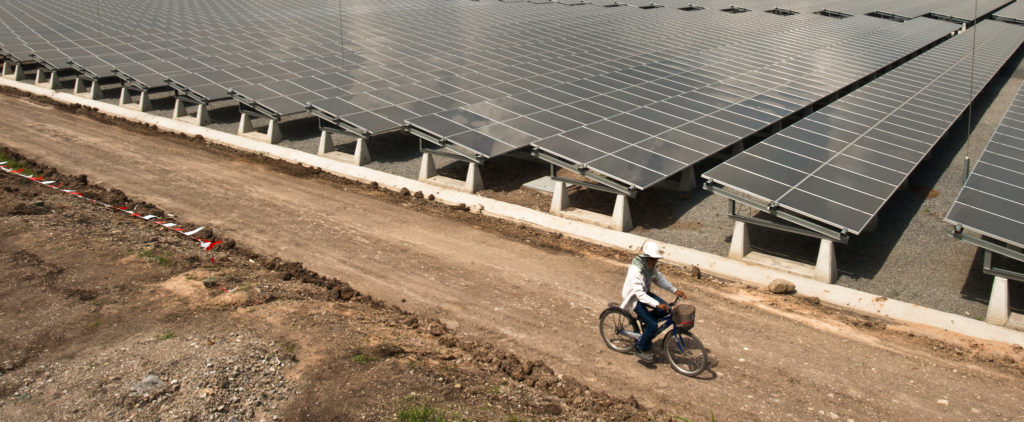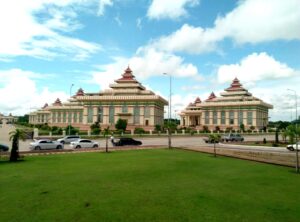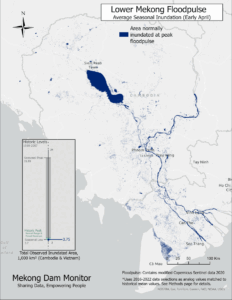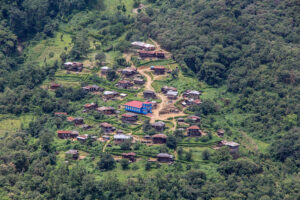
Introduction
Demand for electricity is growing rapidly in Southeast Asia. Average annual electricity demand growth in Cambodia, Laos, Myanmar, and Vietnam over the last decade has often surpassed 10%. Thailand’s electricity demand growth of 3.7% has been notably lower,1Asian Development Bank, “Sector Overview,” Grid-Parity Rooftop Solar Project: Report and Recommendation of the President, November 2016, accessed at https://www.adb.org/sites/default/files/linked-documents/49087-001-so.pdf. and the Power Development Plan 2018 projects a continued average growth rate of 3.8% in coming decades in line with economic projections.2Thailand Ministry of Energy, “Thailand Power Development Plan 2018 (PDP 2018)” [original article in Thai: แผนพัฒนากำลังผลิตไฟฟ้าของประเทศไทย พ.ศ. 2561 – 2580], April 30, 2019, page 3. This lower rate is in part because Thailand is a more developed economy and has already reached 100% electrification. However, projected installation of new power generation capacity is significant as the government aims to replace aging power plants, electrify the transportation sector, and capitalize on its geographic location to serve as an electricity trading hub. While each country in the region makes national determinations about its own energy mix, Thailand imports electricity from neighbors and plays an influential role over which type of projects move ahead in Laos by providing revenue guarantees in the form of power purchase agreements (PPAs).
Regional grid integration provides an opportunity to improve sustainable development by allowing for higher levels of renewable energy penetration throughout the Mekong countries. However, regional coordination in terms of power development and electricity trade is necessary to prevent ecological damage. The construction of dams on the mainstream of the Mekong and on its tributaries in Laos is intended to support regional electricity trade and provides a renewable alternative to fossil fuels—but while renewable, these dams reduce sediment delivery to the agricultural rice-baskets of Cambodia’s floodplains and the Mekong Delta in Vietnam, block fish migration pathways, and alter the natural dry and wet seasonal variance in water levels. Without coordination, the Mekong River’s natural and agricultural productivity could be further damaged even as the region’s overall energy mix becomes less carbon intensive.
Recent disruptions may provide an opportunity to rethink the future energy buildout. In 2019 and 2020, the combined impacts from severe drought and alterations to the natural flow of the Mekong River from upstream hydropower have undermined the flood pulse, which underpins the river’s rich fisheries and provides sediment to farms along the floodplains and in the Mekong Delta. The drought has also negatively impacted hydroelectric power generation, reducing power output and causing blackouts in Cambodia. For instance, Cambodia’s hydroelectricity production dropped by 30% (400 MW out of an installed capacity of 1,341 MW) in 2019. The 2019-2020 drought is the second major drought in the last five years. Most climate projections for mainland Southeast Asia anticipate shifts to location, intensity, and amount of rainfall in ways that would impact future hydropower production, and El Niño events which usually cause low rainfall in Southeast Asia are becoming more intense.3Please check out the following references on climate change in Southeast Asia: Bin Wang, Xiao Luo, Young-Min Yang, Weiyi Sun, Mark A. Cane, Wenju Cai, Sang-Wook Yeh, and Jian Liu, “Historical change of El Nino properties sheds light on future changes of extreme El Nino,” Proceedings of the National Academy of Sciences of the United States of America, November 5, 2019, at https://www.pnas.org/content/116/45/22512; Asian Development Bank (ADB), The Economics of Climate Change in Southeast Asia: A Regional Review, 2009, page 255; Jasparro, C. and J. Taylor, Climate change and regional vulnerability to transnational security threats in Southeast Asia, Geopolitics, 13(2), 2008, pages 232-256 The resulting risks to the power sector should be seriously considered, particularly in countries like Cambodia, Laos, and Myanmar which have high dependency on hydropower.
Other macroeconomic trends have also impacted the regional power sector. The COVID-19 pandemic has caused widespread devastation to the global economy in 2020, and Southeast Asia’s economy contracted 4% in 2020.4Asian Development Bank (ADB), Asian Development Outlook 2021: Financing a Green and Inclusive Recovery, April 2021, page xxii. Quarantine and lockdown practices have driven down demand for electricity in many countries, and for export-focused countries the global economic slowdown has impacted commercial and industrial electricity demand. Thailand’s electricity demand shrinking 3% in 2020.5Energy Policy and Planning Office, “Electricity Consumption for the Whole Country (Classified By Sector)”, Ministry of Energy, accessible from https://www.eppo.go.th/index.php/en/en-energystatistics/electricity-statistic. While disruptions to electricity consumption patterns resulting from the pandemic will not impact long-term electricity needs, the crisis has affected supply chains, workforce movement, and in some cases project pipelines. The drop in demand has also presented short-term financial difficulties to utility companies and may speed along policy changes. For instance, the Electricity Generating Authority of Thailand (EGAT) has announced changes to the reserve margin and is publicly rethinking some PPAs with Laos.
The impacts of the recent drought and COVID-19 are immediate, but they create opportunities for Thailand and its neighbors to accelerate the transition towards a sustainable energy future, adapt to the increasing threat of climate change, and lay out a stronger economic recovery in the post-pandemic environment. Southeast Asia has historically lagged other parts of the world in the adoption of renewable energy technology, but the short-term disruptions to the energy sector make cost competitiveness and resilience in the face of shocks even more important. Renewable energy has proven resilient throughout the pandemic. As decision-makers revisit national targets and plans post-COVID there is a real opportunity to rethink the role of renewable energy and use the momentum of economic recovery to push for reforms and policy changes which support higher integration of renewable energy.
This paper will build on the analysis from the 2019 Thailand Energy Scenarios Study to explore how technological innovations, drought, and the coronavirus are impacting the Mekong region’s energy sector and what this means for Thailand and its neighbors. Thailand has historically been a regional leader and early adopter of renewable energy technologies, including solar panels, wind turbines, and now electric vehicles and battery storage. Despite the devastation caused in the short-term, the drought and pandemic provide an opportunity and motivation for policymakers in the region to rethink their future energy plans and transition to a more resilient future by strategically shifting towards renewables in national recovery and stimulus packages.
.
Key Takeaways and Recommendations:
- Policymakers should reaffirm ambitions to accelerate the energy transition as an integral part of COVID-19 recovery plans. Renewable energy investments will not only bring clear environmental benefits locally and globally, but also have knock-on effects that could support sustainable economic recovery from the COVID-19 economic impacts.
- As Thailand moves towards carbon neutrality, it would be beneficial to strategically plan Thailand’s role as an electricity trading hub for ASEAN to support the region’s overall renewable energy and climate goals. One of the greatest benefits of a regional electricity grid is that it supports higher levels of variable renewable energy electricity projects. As Thailand pursues a long-term goal of becoming an electricity hub, policymakers should plan not only for finding markets for excess power but also lay the foundation for Thailand and its neighbors to take advantage of higher amounts of regional variable renewable energy assets like solar and wind. Updating Thailand’s next Power Development Plan to explicitly include non-hydropower projects in future imports from Laos would lay a forward-looking foundation for Thailand to be a sustainable and flexible electricity trading hub.
- Refusing to sign new power purchase agreements for mainstream hydropower dams in Laos would have financial benefits for EGAT and manage risk for the eight Thai provinces which rely on the Mekong River’s natural resources. The four Mekong mainstream dam projects currently under consideration in Lao PDR (Luang Prabang, Pak Lay, Pak Beng, Sanakham) all intend to export electricity to Thailand, but there is rising concern inside Thailand about the economic, social, and environmental costs of these projects. Starting in late 2020, Thailand’s top water official indicated that the Thai government might reconsider buying electricity from the Sanakham Dam and that Thailand could exercise its right under the 1995 Mekong Agreement to halt the project if the government determined that construction would negatively impact Thailand.6Apinya Wipatayotin, “Govt warns over Lao dam plan,” The Bangkok Post, November 25, 2020, at https://www.bangkokpost.com/thailand/general/2025023/govt-warns-over-lao-dam-plan; Apinya Wipatayotin, “Thai govt threatens to veto new Lao dam,” The Bangkok Post, December 12, 2020, at https://www.bangkokpost.com/thailand/general/2034151/thai-govt-threatens-to-veto-new-lao-dam. Refusing to sign agreements for mainstream dam projects would allow Thai policymakers to better consider costs and benefits of alternative projects, including floating solar proposed on the Nam Ngum 1 and Nam Theun 2 dams.
- Policymakers around the region should prioritize investment towards modernization of the national and regional electricity grid to ensure successful integration of renewable energy technologies and electric vehicles. Investment in new power generation has continuously attracted support from the private sector, but transmission infrastructure needs to be modernized and upgraded in order to support both the new power generation capacity broadly and in particular to incorporate higher levels of renewable energy and potential demand shifts due to electric vehicles.
- The US and Japan should prioritize infrastructure funding from the U.S. Development Finance Corporation and Japan Bank for International Cooperation towards power generation and transmission projects in cross-border clean energy zones. The Japan-U.S. Mekong Power Partnership (JUMPP) has already supported a series of technical assistance projects which support regional energy integration, cross-border power trade, higher deployment of advanced energy technologies, and a multi-sector nexus approach to planning which can help avoid or mitigate impacts of energy projects. The opportunities identified through these technical assistance projects supporting these efforts could be used to help inform investments from Japan and the United States, as well as ACMECS and like-minded development partners. Such projects could also take advantage of COVID-19 recovery funds aimed at green infrastructure.
Notes
- 1Asian Development Bank, “Sector Overview,” Grid-Parity Rooftop Solar Project: Report and Recommendation of the President, November 2016, accessed at https://www.adb.org/sites/default/files/linked-documents/49087-001-so.pdf.
- 2Thailand Ministry of Energy, “Thailand Power Development Plan 2018 (PDP 2018)” [original article in Thai: แผนพัฒนากำลังผลิตไฟฟ้าของประเทศไทย พ.ศ. 2561 – 2580], April 30, 2019, page 3.
- 3Please check out the following references on climate change in Southeast Asia: Bin Wang, Xiao Luo, Young-Min Yang, Weiyi Sun, Mark A. Cane, Wenju Cai, Sang-Wook Yeh, and Jian Liu, “Historical change of El Nino properties sheds light on future changes of extreme El Nino,” Proceedings of the National Academy of Sciences of the United States of America, November 5, 2019, at https://www.pnas.org/content/116/45/22512; Asian Development Bank (ADB), The Economics of Climate Change in Southeast Asia: A Regional Review, 2009, page 255; Jasparro, C. and J. Taylor, Climate change and regional vulnerability to transnational security threats in Southeast Asia, Geopolitics, 13(2), 2008, pages 232-256
- 4Asian Development Bank (ADB), Asian Development Outlook 2021: Financing a Green and Inclusive Recovery, April 2021, page xxii.
- 5Energy Policy and Planning Office, “Electricity Consumption for the Whole Country (Classified By Sector)”, Ministry of Energy, accessible from https://www.eppo.go.th/index.php/en/en-energystatistics/electricity-statistic.
- 6Apinya Wipatayotin, “Govt warns over Lao dam plan,” The Bangkok Post, November 25, 2020, at https://www.bangkokpost.com/thailand/general/2025023/govt-warns-over-lao-dam-plan; Apinya Wipatayotin, “Thai govt threatens to veto new Lao dam,” The Bangkok Post, December 12, 2020, at https://www.bangkokpost.com/thailand/general/2034151/thai-govt-threatens-to-veto-new-lao-dam.




